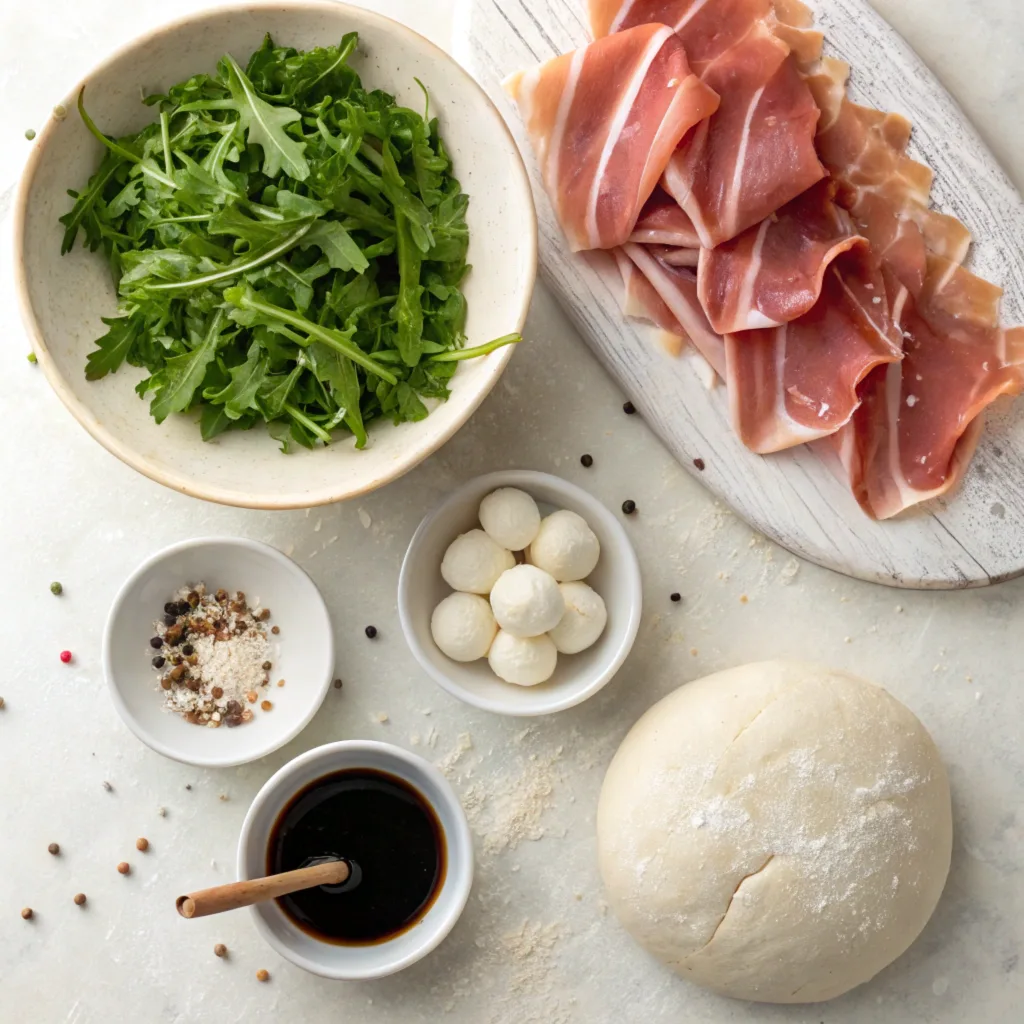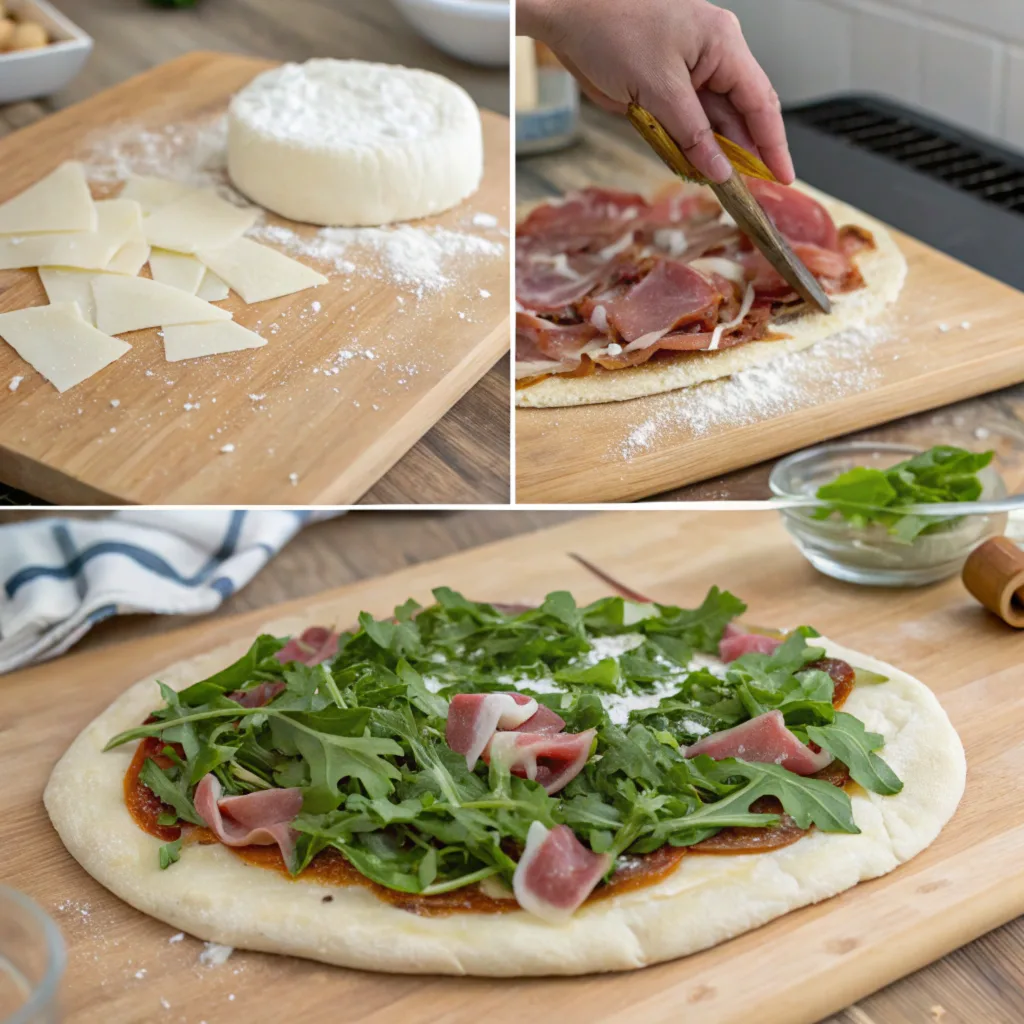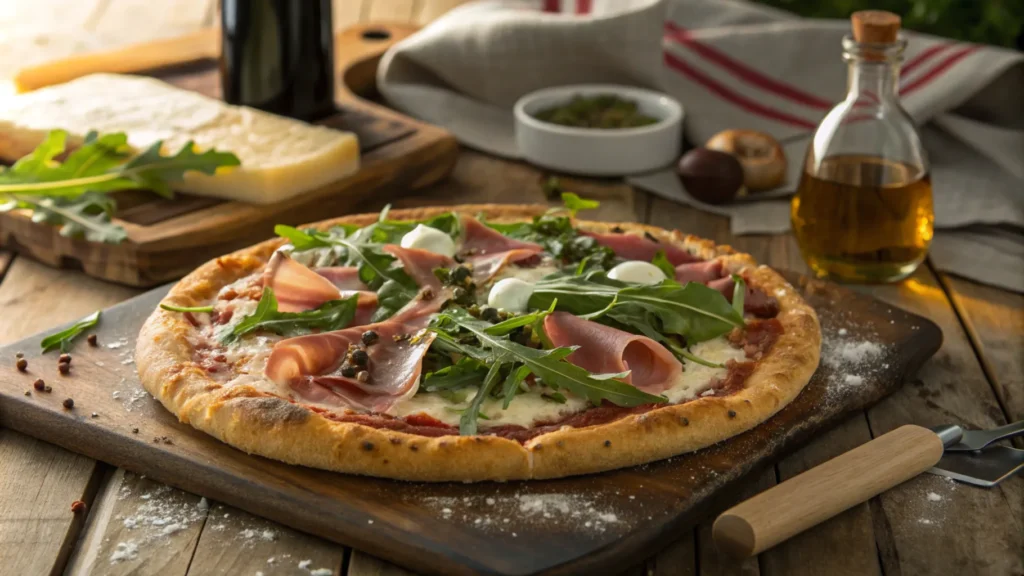Ever have one of those nights where you’re craving something that feels fancy but doesn’t need a reservation or a dress code? That’s when prosciutto and arugula pizza steps in. It’s like dinner’s answer to “business casual” – classy enough for a date night, but still comfortable for movie marathons at home. And if you’re looking to round out the evening with a dessert that’s just as easy yet impressive, check out this recipe for an air fryer apple dessert. Let’s dive into how to make this pizza magic happen, step by step.

Table of Contents
Ingredients for Prosciutto and Arugula Pizza
The heart of any good pizza is what you put on it. Keep it simple, but pick ingredients that pack a punch. Here’s what you’ll need:
- Pizza dough: Store-bought or homemade. No judgment here.
- Olive oil: Just a drizzle to keep things flavorful.
- Garlic: Minced or crushed; fresh is best.
- Mozzarella cheese: Go for fresh if you can—it melts beautifully.
- Prosciutto: Thin slices are key. That salty goodness is what makes it pop.
- Arugula: Adds that fresh, peppery bite.
- Parmesan cheese: Grated on top for extra yum.
- Balsamic glaze: Optional, but a drizzle takes it to another level.

You probably have most of this stuff in your kitchen already, except maybe the prosciutto. It’s worth the trip to grab it though, trust me.
Tools and Equipment Needed
Cooking doesn’t have to feel like a scavenger hunt for gadgets. Here’s a quick list of the essentials:
- A baking sheet or, if you’re feeling fancy, a pizza stone.
- A rolling pin (or even a wine bottle works in a pinch).
- A sharp knife or pizza cutter.
- A mixing bowl for prepping toppings, if needed.
- A spatula for transferring pizza (unless you like playing food Jenga).
- An oven or a grill—because raw pizza dough isn’t exactly appetizing.
If you’re short on tools, don’t stress. Most of this stuff can be swapped out with whatever you’ve got lying around.
How to Make Prosciutto and Arugula Pizza: A Detailed Step-by-Step Guide
Step 1: Preheat the Oven
Set your oven to 475°F, or as close to that as it will allow. High heat is critical because it gives you that crisp, restaurant-style crust. If you have a pizza stone, place it in the oven during preheating. A hot stone not only guarantees even cooking but also gives the base a slightly smoky flavor.
Step 2: Prep the Dough
Lay your dough out on a lightly floured surface to prevent sticking. Roll it to about a quarter-inch thickness, but don’t stress about perfection. Rustic shapes give it that homemade vibe. If you don’t have a rolling pin, a clean wine bottle works just as well. Move the dough to your baking sheet or pizza peel if you’re using a stone.
Pro Tip:
If you prefer a thinner crust, use your fingertips to stretch the dough instead of rolling it. It adds a nice texture and reduces the risk of overworking it.
Step 3: Add the Base
Brush the rolled-out dough lightly with olive oil, focusing on the edges to help them brown nicely. Then, sprinkle minced garlic evenly across the surface. This garlic-oil combo adds a rich, savory foundation for the toppings without overwhelming them.
Quick Tip:
If you’re in a hurry, you can swap minced garlic for garlic powder. It still provides a punch of flavor but cuts down on prep time.
Step 4: Layer the Cheese
Take your mozzarella—preferably fresh—and tear it into small chunks or thin slices. Spread them out across the dough, leaving some gaps. These spaces allow the crust to puff up slightly and create that bubbly, golden look. Don’t overload the cheese; too much can make the pizza soggy.
Optional Extra:
Add a sprinkle of shredded Parmesan at this stage for a deeper, nutty flavor base.
Step 5: Bake the Pizza
Carefully transfer your prepared pizza to the oven. If you’re using a stone, slide it directly onto the surface using your pizza peel or a floured baking sheet. Bake for 8-10 minutes, keeping a close eye. You’re aiming for melted cheese with light browning and a crispy, golden crust.
Tip for Crispier Crust:
If your oven has a broiler, you can turn it on for the last minute of baking. This gives the cheese a bit more caramelization without overcooking the base.
Step 6: Add Prosciutto and Arugula
Remove the pizza from the oven and let it sit for a minute or two. This small pause prevents the arugula from wilting too much when it hits the hot surface. Lay thin slices of prosciutto across the pizza, followed by a generous handful of fresh arugula. The peppery greens paired with the savory meat create the perfect balance.
Serving Tip:
For an even distribution, lightly toss the arugula in olive oil before adding it. This keeps the greens shiny and helps them adhere to the pizza.

Step 7: Finish with Parmesan and Glaze
Top everything off with freshly grated Parmesan for a sharp, salty kick. If you have balsamic glaze on hand, drizzle a thin stream across the pizza. The glaze’s sweet tang perfectly complements the salty prosciutto and bitter arugula.
Skip the Glaze?
No problem. A squeeze of fresh lemon juice over the arugula can offer a similar bright contrast to the rich toppings.
This step-by-step method not only simplifies the process but also gives you plenty of flexibility to tweak things to your taste. By following these instructions, you’ll have a prosciutto and arugula pizza that’s crispy, flavorful, and packed with personality.
Tips for Prosciutto and Arugula Pizza
- Shortcut your dough: Store-bought dough or even flatbreads work if you’re short on time. No one’s judging.
- Don’t overload: Too much cheese or prosciutto can make it soggy. Less is more sometimes.
- Keep arugula fresh: Add it right before serving to keep it crisp and vibrant.
- Preheat like you mean it: A hot oven or stone is what gives you that pizzeria-style crust.
- Experiment with balance: If the prosciutto’s too salty, a sweeter balsamic glaze evens it out.
Variations of Prosciutto and Arugula Pizza
The beauty of this pizza is how easily it adapts. You can switch things up depending on what you’ve got or how adventurous you’re feeling.
- Add some fruit: Thinly sliced figs or pears add a touch of sweetness that works surprisingly well with the salty prosciutto.
- Spicy kick: Sprinkle red pepper flakes for a bit of heat. Trust me, it’s worth trying.
- Cheese swap: Try goat cheese or ricotta instead of mozzarella for a creamier vibe.
- Gluten-free crust: If you’ve got dietary needs, use a cauliflower or gluten-free base. It works great with these toppings.
- Herb boost: Add fresh basil or thyme for a little extra zing.
Nutritional Benefits of Prosciutto and Arugula Pizza
This pizza is more than just a tasty treat; it has some surprising perks for your health.
- Arugula is the quiet hero here. It’s packed with vitamins A and C, calcium, and antioxidants. Its slightly bitter flavor also helps balance the richness of the prosciutto.
- Prosciutto, though indulgent, offers protein and a touch of iron. Just go easy on the portions—it’s delicious but salty.
- Mozzarella provides calcium and a satisfying creaminess, but fresh mozzarella is lower in sodium compared to pre-shredded options.
- Balsamic glaze brings sweetness without loading on extra calories, especially if you drizzle lightly.
This pizza strikes a nice balance between indulgence and lighter toppings, making it a satisfying choice for pizza night.
Storage and Reheating Tips for Prosciutto and Arugula Pizza
If you’ve got leftovers (unlikely but possible), keeping them fresh is key.
- Storage: Wrap slices in foil or place them in an airtight container. Refrigerate them for up to three days.
- Reheating in the oven: Preheat to 375°F, place the pizza on a baking sheet, and heat for about 7-10 minutes. This keeps the crust crisp.
- Reheating on the stove: Use a skillet for a quick reheat. Cover the pan for a minute to melt the cheese.
- Avoid the microwave: It’ll make your crust soggy. If it’s your only option, use short bursts of heat.
Remember to add fresh arugula after reheating, so it stays vibrant and crunchy.
Serving Suggestions for Prosciutto and Arugula Pizza
This pizza is versatile, making it perfect for casual dinners or a centerpiece for fancier meals.
- Serve it hot from the oven with a light salad on the side. A citrus vinaigrette pairs well.
- Pair with a glass of wine, like a crisp Sauvignon Blanc or a light red like Pinot Noir.
- Make mini versions for a party platter—easy to share and always a crowd-pleaser.
- For a family night, add a few toppings like cherry tomatoes or caramelized onions for variety.
No matter how you serve it, prosciutto and arugula pizza feels like a step up from your usual pepperoni slice.
FAQs
Should prosciutto go on pizza before or after cooking?
Always after. The delicate slices of prosciutto can dry out and lose their rich texture if exposed to heat for too long. Add it fresh after baking for the best flavor.
Should I put arugula on my pizza before or after cooking?
After! Cooking arugula can make it wilt too much. Adding it fresh keeps its peppery bite and crisp texture intact.
Is prosciutto pizza healthy?
It can be. While prosciutto is higher in sodium, balancing it with fresh greens like arugula and lighter cheese options makes this a better choice than heavier pizzas.
What does arugula taste like on pizza?
It’s got a peppery, slightly bitter flavor that complements the salty prosciutto and creamy cheese. It’s almost like having a salad on your pizza, but better.
A Beginner’s Guide to Prosciutto and Arugula Pizza
If you’re new to making pizza, don’t sweat it. Start with these simple steps:
- Use pre-made pizza dough if making your own feels intimidating.
- Stick with basic ingredients: olive oil, garlic, mozzarella, prosciutto, and arugula. Less is more here.
- Don’t overthink the technique. Even if your crust isn’t perfectly round, it’s still pizza.
- Bake the pizza hot and fast—no slow cooking here.
Once you’ve got the basics down, you’ll find it’s easier than you imagined.
Advanced Tips for Prosciutto and Arugula Pizza
Feeling adventurous? Here are some pro tricks:
- Char the crust: If you have a grill, use it. A bit of char on the bottom of the crust adds depth to the flavor.
- Homemade balsamic glaze: Simmer balsamic vinegar with a bit of sugar until it thickens. It’s better than store-bought and lets you control the sweetness.
- Experiment with doughs: Try sourdough for a tangy twist or semolina flour for added texture.
- Layer strategically: Add a sprinkle of Parmesan under the mozzarella to keep the crust from getting soggy.
These little tweaks take your pizza from great to unforgettable.
The Appeal of Prosciutto and Arugula Pizza
Why do people love this pizza so much? It’s the balance. The salty, savory notes of the prosciutto blend smoothly with the fresh arugula and creamy cheese. It feels indulgent without being heavy, and the flavors are so vibrant, they practically pop off the plate. Whether you’re feeding picky eaters or hosting foodies, it’s a dish that impresses every time.
Homemade vs. Store-Bought Prosciutto and Arugula Pizza
There’s no wrong choice here—just different experiences.
- Homemade Pizza: You control everything. The crust can be as thick or thin as you like, and you can get creative with toppings.
- Store-Bought Pizza: It’s fast and easy. Many grocery stores now carry artisan-style frozen pizzas featuring prosciutto and arugula.
Homemade definitely adds a personal touch, but store-bought options are great in a pinch. Either way, the flavors shine through.
Conclusion
Making prosciutto and arugula pizza is less about perfection and more about enjoying the process. It’s easy to tweak to your taste, works for casual and fancy occasions, and always leaves you with a pizza worth sharing. Whether you’re a beginner or a seasoned home cook, this recipe never gets old. Give it a shot—you’ll be glad you did.


